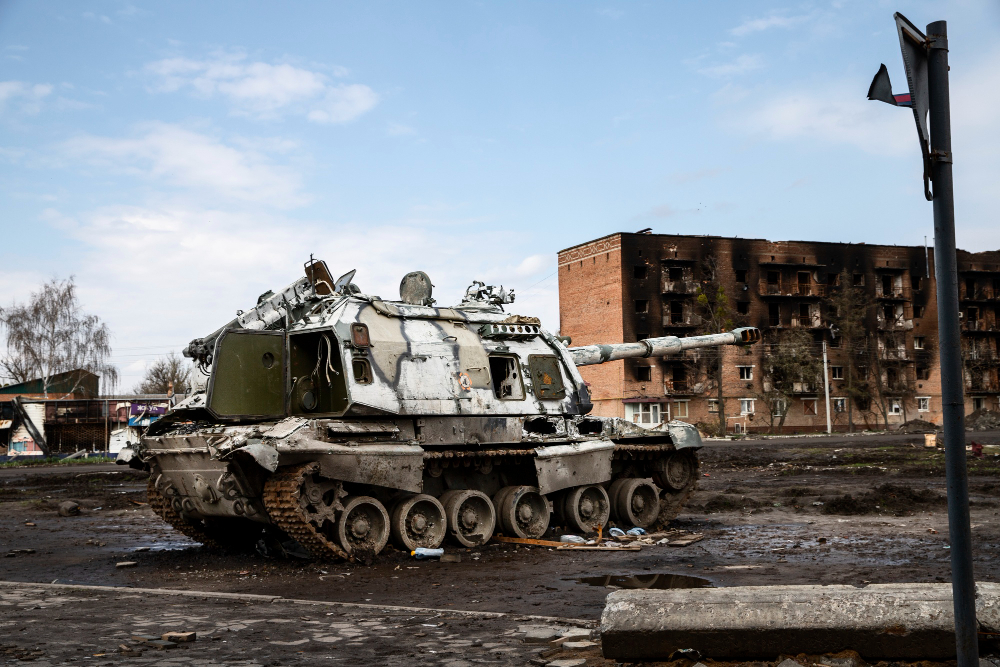Original article (in Bosnian) was published on 17/03/2023
A photo of a battle tank stuck in the mud with a Russian flag is being shared on social networks, with false claims that it was captured by Russian forces near Bakhmut.
In recent weeks, the world media has focused on the fighting around Bakhmut, a city located in the Donetsk region of Ukraine. As reported by N1, the Russian army currently controls slightly less than half of Bakhmut. The city was destroyed, tens of thousands of people were killed, and more than 90 percent of the inhabitants left it. The battles for Bakhmut, in addition to increased media attention, are accompanied by disinformation.
On March 1, 2023, a photo of a battle tank with a Russian flag stuck in the mud was published on Twitter. On the photo, March 1st is written as the date of creation, and Artemivsk (the old name for Bakhmut) is listed as the location.
The tweet states that the battle tank got stuck during the battle, “after 100 meters”, and that it was captured with the Polish crew.
Today, March 1, at 08:40 in the morning, the German Leopard 2 battle tank launched an attack near Artemivsk, but after 100 meters this 60-ton colossus was completely trapped in the mud.
The assault group of our fighters managed to capture the enemy tank together with the Polish crew.

We found the photo on several other Twitter profiles, where it was shared with a similar description (link, link), and where it is claimed that Polish and German mercenaries were captured on that occasion and that the tank was allegedly captured by members of the private paramilitary group Wagner.
We found the same photo on Facebook (link, link).
What are the facts?
Leopard 2 battle tanks are manufactured by the German company Krauss-Maffei Wegmann. After a long hesitation, Germany decided on January 24 to send these battle tanks to Ukraine. It was also decided that these battle tanks can be delivered to Ukraine by other countries that own them. At the time, it was said that the first delivery from Germany would be by the end of the quarter. Some other countries also announced to send battle tanks after Germany’s decision. After it was announced at the end of January, Poland delivered the first tanks to Ukraine on February 24.
Shortly after this news, the Leopard battle tanks became the subject of disinformation. Already on February 26, users of social networks began to spread false claims that members of Wagner destroyed the first battle tank in the district of the village of Jagodno and captured the Polish-German crew. Claims that the Leopard battle tank was captured were updated again at the beginning of March, when users of social networks and Russian-language media announced that the battle tank was captured near Bakhmut, referring to the statement of the deputy secretary of the Donetsk branch of the United Russia party Aleksej Muratov (link). Claims of a captured battle tank then began to be shared, along with a photo of a battle tank stuck in mud featuring a Russian flag (link, link).
However, there is no official confirmation that it was really captured, which was immediately pointed out by some Russian media, quoting Muratov’s statement. On March 3, the Russian website Vesma published an article stating that even after two days, no evidence has been presented about the alleged capture of a Leopard battle tank near Bakhmut.
The photo shared by social media users as proof was photoshopped. Numerous fact-checking platforms have written about this (link, link, link, link).
As stated in these analyses, the original photo without the Russian flag has been available on the Internet since 2006, and in a post on a Danish blog it was stated that its author is Claus Ronald Jansen. The Greek fact-checking platform Ellinika Hoaxes contacted Jansen, who confirmed that he had taken the photos and stated that they were from an incident that happened during a drill in Denmark on January 24, 2002. On March 6, 2023, Jansen also posted on his Facebook profile and wrote that he took a photo of a battle tank in the mud more than 20 years ago and that today it is used as a means of propaganda in the context of the war in Ukraine.
Accordingly, we evaluate the first publication of the claim that the photo shows a battle tank captured by Russian forces on March 1st near Bakhmut as fake news. Other appearances are rated as the distribution of fake news.

